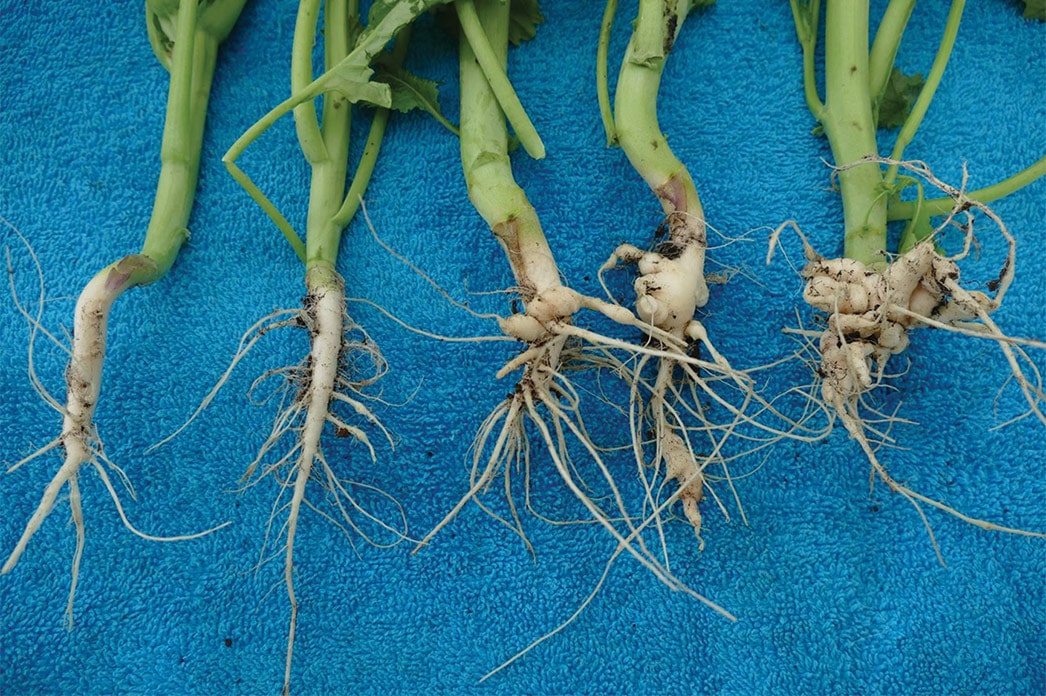Saskatchewan Bulletin
Who should grow a clubroot-resistant variety?

The Canadian recommendation is for farmers to grow clubroot-resistant (CR) varieties as part of a holistic clubroot farm management plan. The CR trait will prevent most infection, which will help to keep spore counts low in fields that already have lower counts. With fewer resting spores in the soil, the risk of building up new virulent pathotypes that can overcome the clubroot resistance being used is reduced.
A minimum two-year break between canola crops (three-year rotation) does not guarantee to keep clubroot away, but when combined with a clubroot resistant variety, it helps to keep clubroot spore numbers in the soil at low levels. When spore counts reach high levels, the clubroot pathogen is more easily moved from field to field because there are now potentially billions of spores present in soil clumps attached to equipment. Furthermore, clubroot will cause yield loss in susceptible canola (even with a four-year rotation). Finally, the clubroot pathogen will overcome CR resistance if resistant varieties are used repeatedly in tight (one-year break or continuous) canola rotations. There is no reason not to grow a clubroot variety if clubroot is present in your region, especially if the CR variety also has the blackleg resistance genes, maturity or other traits that you value for the particular field or farm. If clubroot is present in fields around you, growing a canola variety that has CR is your top priority.
Use the following checklist to decide whether a CR variety is right for your farm. If you can answer “true” to all five, you may not need a CR variety. If any one statement is “false”, a CR variety may be the best choice.
- I vigorously checked all of my fields (not just those in canola this year) to confirm that clubroot is not present on my farm.
- I sent in soil samples from fields that will be in canola next year and they tested negative for the pathogen.
- My neighbours have checked their fields and they don’t have clubroot.
- I have not heard of any clubroot in my municipality.
- No outside equipment/traffic has entered my fields since I last scouted and tested them for clubroot.
How to preserve the trait
While CR genetics show a lot of promise, relying on genetics alone to manage clubroot is not enough. Two-year breaks between canola crops and control of host weeds (which include volunteer canola, flixweed, stinkweed, shepherd’s purse, wild mustard and other brassica crops) are two other steps required to reduce spore buildup.
This is important because each time a susceptible host is grown in the presence of the disease, clubroot disease spores multiply, making management more difficult. Pathotype 3H, the predominant pathotype, is very well controlled by the genetics available in current varieties. Screening of field clubroot spore populations show that there are other pathotypes present as well. This diversity in pathotypes allows the pathogen to persist by favouring development of those pathotypes not controlled by resistant varieties. Managing new genetic tools properly through lower risk crop rotations and agronomic practices will be necessary to preserve their effectiveness against clubroot.
While commercial pathotype tests are not available at this time, growers can test soils for the presence and quantity of clubroot spores. Soil samples for testing can be gathered in the fall. Contact your provincial growers organization to find out how to sample and where to send them.
For a quick comprehensive article on clubroot management, read “Clubroot 101: How to Keep Spores Low and Local” here. For more detail on all aspects of clubroot management, read the “Control clubroot” here.
Clubroot resistance for 2020
Saskatchewan farmers…if you grow canola in an RM where clubroot has been identified, you should strongly consider booking a clubroot-resistant variety for the 2020 crop year. View the Saskatchewan clubroot map here.
Reminder: Participate in Saskatchewan Clubroot Survey
SaskCanola has invested $170,000 to test soil samples collected throughout Saskatchewan for the provincial clubroot survey.
Samples for the 2019 Saskatchewan Clubroot Survey will be collected until the end of September by Plant Health Officers (SARM), with support from the Ministry of Agriculture and Saskatchewan Crop Insurance Corporation staff. Farmers can also submit a free, voluntary sample from their field by obtaining a sample bag from a Ministry of Agriculture Regional Office. Confirmed cases from the voluntary samples will be used to help update the Saskatchewan Clubroot Map. Individual farm locations will not be included on the map.
For more information, contact SaskCanola at 1-877-241-7044.
SaskCanola Announces Morris
Sebulsky Endowment Fund
 SaskCanola is pleased to announce an endowment fund in honour of Morris Sebulsky, a well-respected farmer from east-central Saskatchewan and agricultural engineering lecturer at the University of Saskatchewan. Mr. Sebulsky bequeathed over $2.8 million to the U of S, 4-H, four commodity associations, and his neighbouring towns and rural municipalities. The funds SaskCanola received from the Sebulsky estate have been matched by levy dollars to invest in equipment and demonstrations at research stations across Saskatchewan.
SaskCanola is pleased to announce an endowment fund in honour of Morris Sebulsky, a well-respected farmer from east-central Saskatchewan and agricultural engineering lecturer at the University of Saskatchewan. Mr. Sebulsky bequeathed over $2.8 million to the U of S, 4-H, four commodity associations, and his neighbouring towns and rural municipalities. The funds SaskCanola received from the Sebulsky estate have been matched by levy dollars to invest in equipment and demonstrations at research stations across Saskatchewan.
Visit Partnerships and Programs for more information.
Don’t miss our upcoming leadership workshop!
November 29 & 30, 2019
Saskatoon
Have you considered joining a board? Want to build your leadership capacity? Then SaskCanola’s Learn to Lead is the workshop you’ve been looking for! Interested individuals are invited to contact SaskCanola by September 27 to put their name forward for consideration – 25 lucky farmers will be chosen to participate in this fourth annual, top-notch learning and networking event.
SaskCanola Invests in Safety
SaskCanola is a proud sponsor of the Canadian Agricultural Safety Association’s BeGrainSafe trailer. Our investment supports grain safety education and entrapment rescue training in rural Saskatchewan communities.
This year, SaskCanola signed the Saskatchewan Health & Safety Leadership Charter and committed to the Mission Zero initiative to encourage a change in culture, thought and behavior to bring about an injury-free Saskatchewan.
Canola In Focus Photo Contest

From your fields to the world, agriculture defines Saskatchewan. SaskCanola is bringing canola into focus and we want you to get involved! We’re looking for images that showcase Saskatchewan farmers and the crops you grow. We welcome any images that represent the crop production cycle, from preparations to seeding through harvest. Crop and plant shots that include canola will be favoured. Photo entries will be accepted until October 31, 2019. Three grand prizes will be awarded based on skill.
For photo specifications and full contest details, please visit the #CanolaInFocus 2019 Photo Contest.






